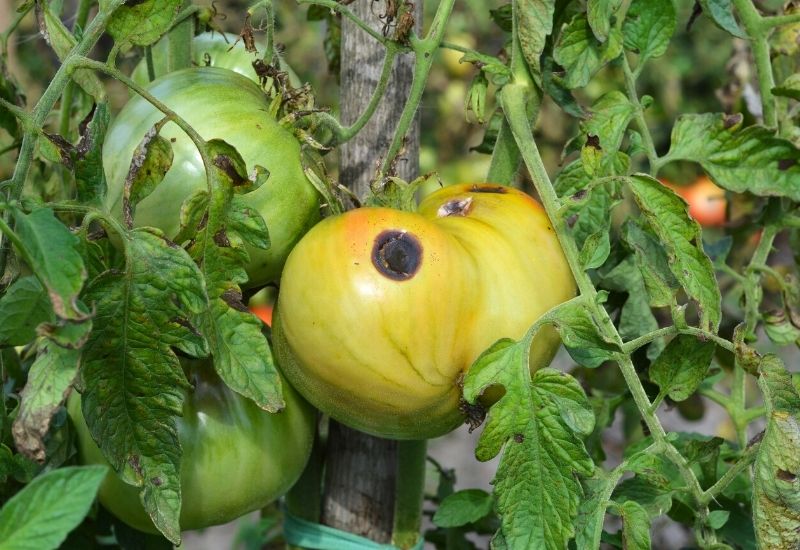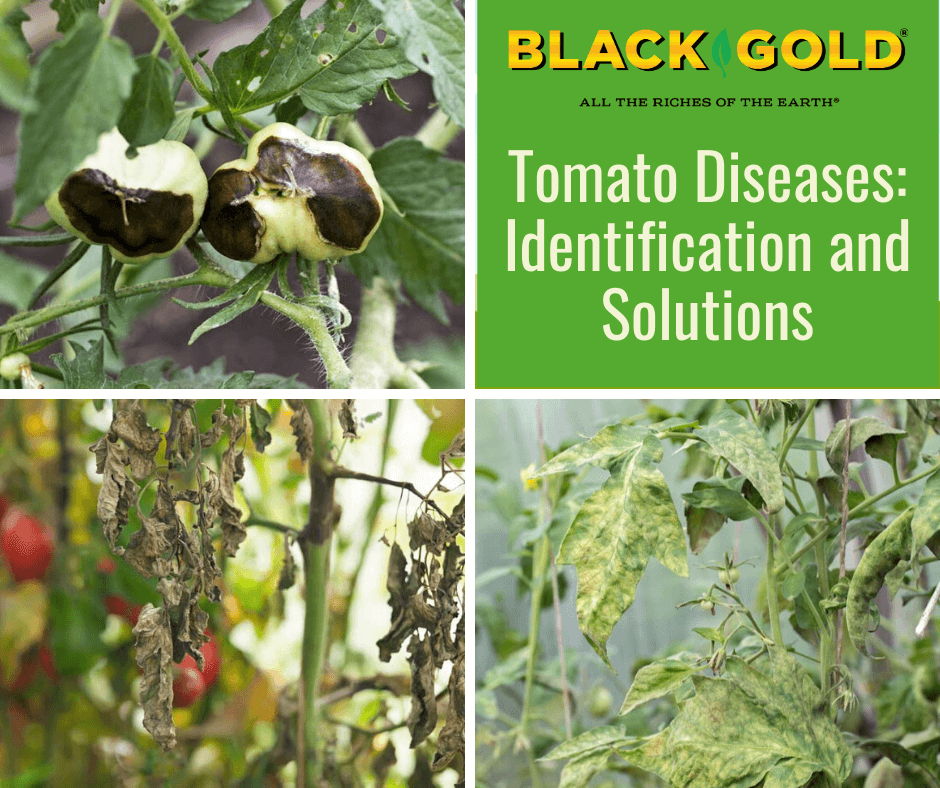To get rid of black spots on tomatoes, remove affected fruits and improve air circulation around plants. Treat remaining plants with fungicides to control disease.
Black spots on tomatoes can be frustrating for gardeners. These blemishes often indicate underlying issues, such as fungal infections or environmental stress. Factors like humidity, poor air circulation, and improper watering can contribute to this problem. Early detection is key to preventing the spread of black spots.
Maintaining a healthy garden ecosystem will support vigorous plant growth. Regularly inspecting your plants helps catch issues before they worsen. This guide will explore effective strategies to eliminate black spots and promote healthy tomato production. By addressing these concerns, you can enjoy a bountiful harvest of fresh, unblemished tomatoes.

Credit: www.gardeningchores.com
How to Get Rid of Black Spots on Tomatoes : Step by Step Guide
Identifying Black Spots On Tomatoes
Black spots on tomatoes can be a sign of trouble. These spots may appear on the skin or flesh. They often look dark and can be round or irregular. Pay attention to the size and color of these spots. They can indicate a serious issue.
Common causes of black spots include:
- Fungal infections: These can spread quickly in wet conditions.
- Bacterial infections: They can cause dark lesions and decay.
- Nutrient deficiencies: Lack of calcium can lead to blossom end rot.
- Pests: Insects may damage the plant and create dark spots.
Preventive Measures For Healthy Plants
Choosing resistant varieties of tomatoes helps reduce black spots. Look for types labeled as disease-resistant. These plants can better withstand various diseases.
Proper plant spacing is key for healthy growth. Space plants at least 24 to 36 inches apart. This allows air to circulate and reduces humidity. Good air flow helps prevent fungal diseases.
Keep the garden clean. Remove any dead leaves or debris. This can harbor pests and diseases. Regularly inspect plants for signs of trouble.
The Role Of Nutrition In Preventing Black Spots
Tomato plants need essential nutrients to grow healthy. Key nutrients include nitrogen, phosphorus, and potassium. These nutrients help prevent black spots. Proper soil testing reveals nutrient levels.
Amendments can improve soil quality. Adding organic matter boosts nutrient content. Use compost to enrich the soil. Calcium is also vital for preventing spots. It strengthens cell walls in tomatoes.
| Nutrient | Role |
|---|---|
| Nitrogen | Promotes leaf growth |
| Phosphorus | Encourages root development |
| Potassium | Enhances fruit quality |
| Calcium | Prevents blossom end rot |
Cultural Practices To Keep Tomatoes Spot-free
Proper watering techniques help prevent black spots on tomatoes. Water plants early in the morning. This practice allows the leaves to dry quickly, reducing disease risk. Use drip irrigation to keep water off the foliage. This method delivers moisture directly to the roots.
Mulching offers several benefits for tomato plants. It helps maintain soil moisture and regulates temperature. Organic mulch, like straw or wood chips, also suppresses weeds. This reduces competition for nutrients and water. Additionally, mulch can protect fruits from soil-borne diseases.
Regularly check your mulch layer. It should be about 2-3 inches thick. Replenish it as needed to ensure maximum benefits for your tomato plants.
Organic Solutions To Black Spot Problems
Black spots on tomatoes can be a big problem. Use natural remedies to help. Here are some effective options:
- Neem oil is a great natural fungicide. It protects against many diseases.
- Mix baking soda with water. Spray it on plants for better results.
- Garlic spray can keep harmful fungi away. Blend garlic with water for a solution.
- Milk spray can also help. It boosts plant health and fights spots.
Other organic fungicides can be useful. Look for products made from copper or sulfur. Always read the instructions before use. Apply them during dry weather for best results.

Credit: blackgold.bz
Chemical Controls: When And How To Use Them
Selecting the right fungicide is essential for treating black spots on tomatoes. Choose a product that targets fungal issues specifically. Look for labels that mention black spots or leaf blight. Read user reviews to find effective options. Always follow the manufacturer’s instructions for the best results.
Application is key for effectiveness. Spray in the early morning or late afternoon to avoid sunburn on plants. Ensure even coverage on both sides of the leaves. Wear gloves and a mask to protect yourself. Keep pets and children away during and after application.
Reapply every 7 to 14 days, especially after rain. Monitor plants regularly to catch new spots early. Combine chemical controls with good garden practices for the best outcome.
Pruning And Maintenance For Optimal Health
Pruning helps keep your tomato plants healthy. Start by removing any dead or yellowing leaves. This allows better air circulation and sunlight. Always use clean, sharp tools to prevent disease.
Cut just above a leaf node to encourage new growth. Focus on removing suckers that grow between the main stem and branches. This improves energy flow to the fruit.
Sanitation is key for tomato health. Keep the garden free from fallen leaves and debris. Always wash hands after handling plants to avoid spreading diseases. Regularly disinfect tools after use.
Monitoring And Ongoing Care
Regular inspections of your tomato plants are crucial. Check the leaves and fruit often. Look for black spots or any signs of disease. Early detection helps prevent further damage.
Adjust care based on the needs of your plants. If you notice black spots, change watering habits. Ensure plants get enough sunlight and nutrients. Use organic fertilizers to boost health. Monitor for pests that may cause stress.
Keep the garden clean and free of debris. Remove any infected leaves immediately. This helps prevent the spread of disease. Healthy plants are better at fighting off problems.
:max_bytes(150000):strip_icc()/identifying-and-controlling-septoria-leaf-spot-of-tomato-1402974-02-b556ef33db30454dbc021c3e7cea89b5.jpg)
Credit: www.thespruce.com
Frequently Asked Questions
How Do I Prevent Black Spots On Tomatoes?
To prevent black spots on tomatoes, ensure proper watering practices. Water the plants at the base and avoid wetting the leaves. Also, provide adequate spacing for air circulation. Regularly check for pests and diseases, and use disease-resistant tomato varieties. Finally, maintain soil health with balanced nutrients.
What Causes Black Spots On Tomato Plants?
Black spots on tomato plants are often caused by fungal infections, such as early blight. Environmental factors like excessive moisture and poor air circulation can also contribute. Nutrient deficiencies, particularly a lack of potassium, may lead to black spots. Regular monitoring and proper care can help mitigate these issues.
Can I Eat Tomatoes With Black Spots?
While it’s often safe to eat tomatoes with minor black spots, it’s best to inspect them closely. If the spots are superficial, you can cut them out. However, if the tomatoes feel mushy or have extensive rot, it’s better to discard them.
Always prioritize food safety.
How Do I Treat Black Spots On Tomatoes?
To treat black spots on tomatoes, remove affected leaves and improve air circulation. Apply fungicides specifically designed for tomatoes to combat fungal issues. Ensure you are watering properly and avoid overhead watering. Additionally, consider crop rotation and using resistant varieties for long-term prevention.
Conclusion
Maintaining healthy tomato plants is essential for a bountiful harvest. By implementing the tips shared, you can effectively combat black spots. Regular monitoring, proper watering, and good air circulation can make a significant difference. Enjoy the satisfaction of growing vibrant, spot-free tomatoes in your garden.
Happy gardening!

